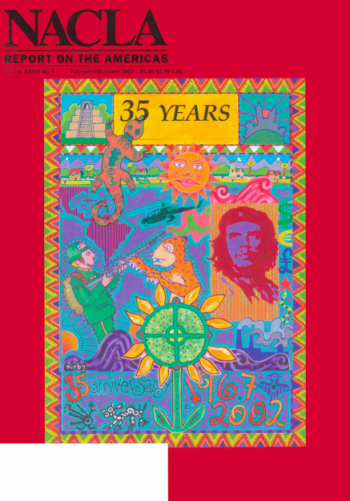Report
Soon, however, the fledgling organization was turning out a lengthening list of publications: Early NACLA Newsletters included analyses of the penetration of Latin America by U.S. corporate interests: “Kaiser’s Global Empire,” “The Hanna Industrial Complex,” “Brown Bros.
In the winter of 1969-70, five staff members moved to the San Francisco Bay area and established a second NACLA office in Berkeley. Fred Goff, who had lived in California and was anxious to move back, had gone out earlier to investigate the possibilities of establishing a West Coast office, and found a large West Coast constituency—mostly academics—that could potentially be very supportive of NACLA’s work.
NACLA’s “decollectivization” was well underway by the early 1990s. Everyone had a job title and there were intended lines of authority.
The fall of the Berlin Wall in 1989 and the collapse of the Soviet Union three years later created a world fundamentally different from the one in which the Latin American left had been active.
In 1981, Salvadoran politics took a turn for the grisly: In November, the five-man executive committee of the Democratic Revolutionary Front (FDR), the chief civilian opposition to the increasingly brutal military-civilian junta, was rounded up, tortured and killed.
“In September, 1973, I was a 26-year-old doctoral student finishing my dissertation research ... my own political interests soon brought me into contact with a small group of progressive, young North Americans.
On July 19, 1979, the Sandinista National Liberation Front (FSLN) toppled the U.S.-supported Somoza family dictatorship that had ruled Nicaragua for nearly a half century. Later that same year, a coup of seemingly progressive “young colonels” overthrew El Salvador’s military government only to turn repressive and exclusionary themselves.
With the election of Allende’s Popular Unity coalition (UP), hopes for a “democratic road” to socialism ran high; fears that the United States wouldn’t allow an elected socialist government to succeed in the Americas ran even higher.
Black left NACLA two years later and his critical stance was taken up by a new recruit named Mark Fried. Fried, like Janet Shenk, started reading NACLA Report as an undergraduate. He was a 19-year-old student at Friends World College in 1973 when someone gave him a copy of NACLA’s New Chile and he found it fascinating.
The very apparent vulnerabilities of democratic socialism, combined with the secrecy induced by government surveillance, attracted one group of Naclistas to Leninist strategies and forms of organization.
“The most valuable characteristic of NACLA was its decision and ability to respond to events. Whether it was the 1968 massacre of hundreds of radical students in Mexico City or what was happening at Columbia [University in New York] and the student movement at home, NACLA was able to respond.
“Much thinking on the left still relied on traditional definitions of public and private spheres, blinding it to the fact that the so-called private sphere was also a political space.
“In order to administer an empire efficiently,it is necessary to construct an apparatus for collecting, analyzing and acting upon information concerning foreign territories.
In April 1965, President Lyndon Johnson sent some 22,000 U.S. Marines to the Dominican Republic to crush a military and popular uprising that sought to restore the constitutional rule of President Juan Bosch.
Steven Volk notes that Salvador Allende “promised to lead Chile through a peaceful transition to socialism, using the legal system of Chile to establish a new economic and political order.”
The first issue of NACLA Newsletter, the magazine that was to become NACLA Report on the Americas, rolled off a mimeograph machine in New York in February 1967. The North American Congress on Latin America, its fledgling publisher, had just come together as a coalition of “New Left” student activists.

